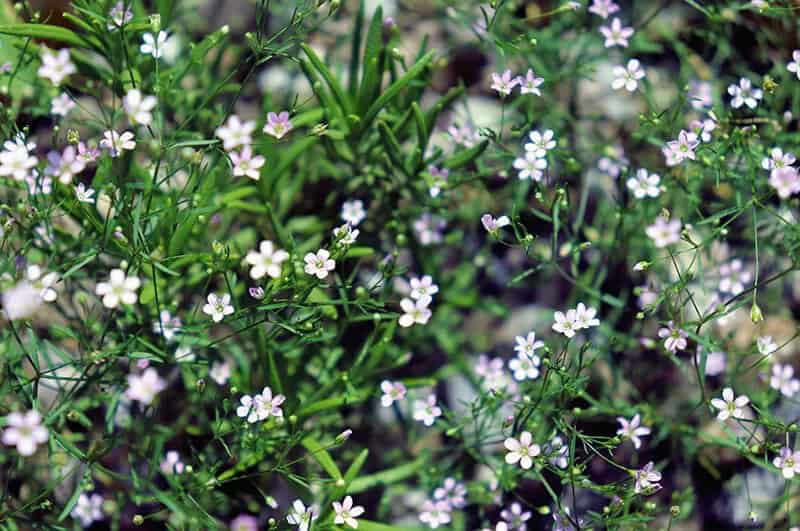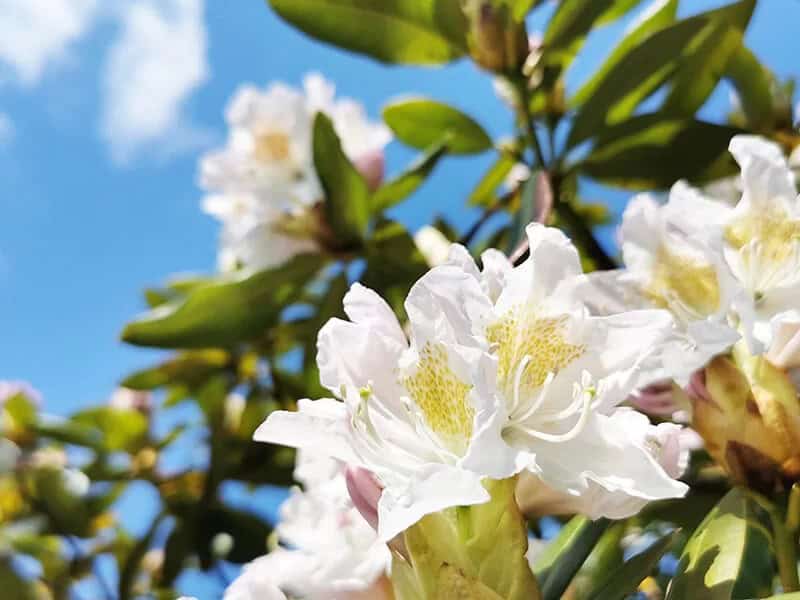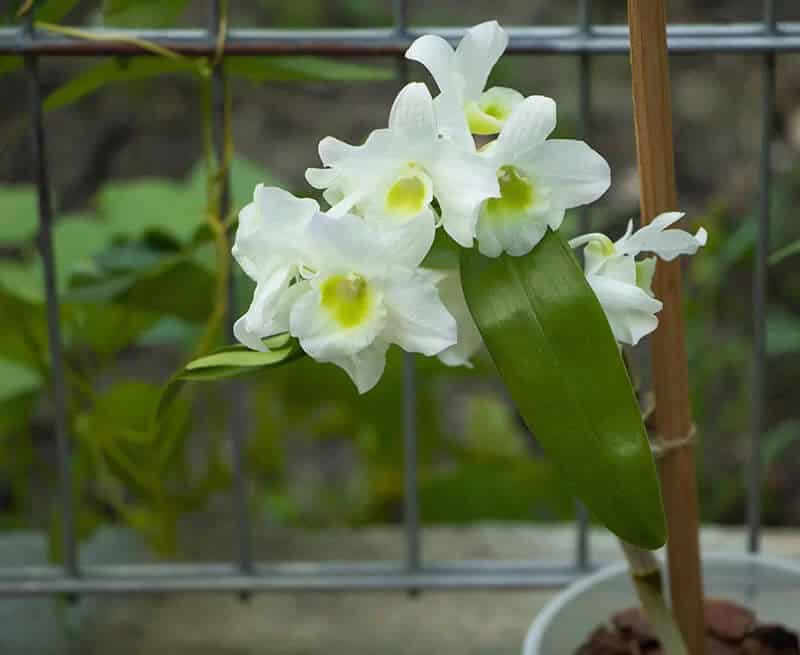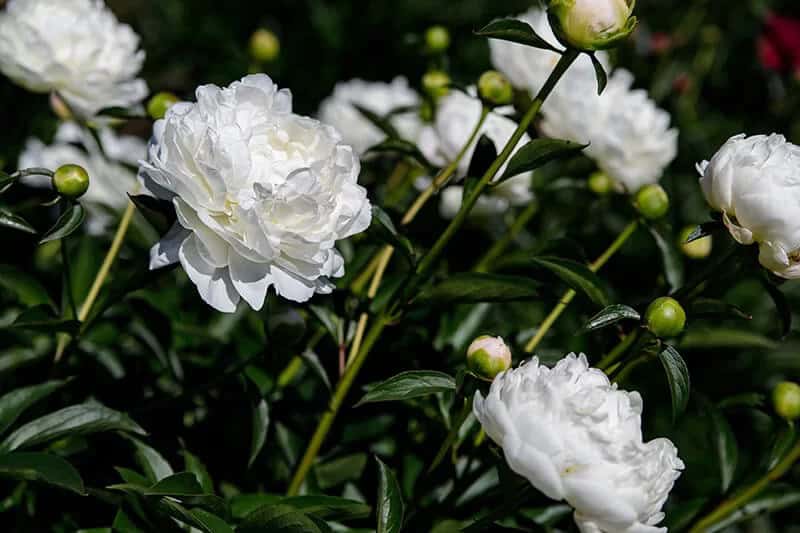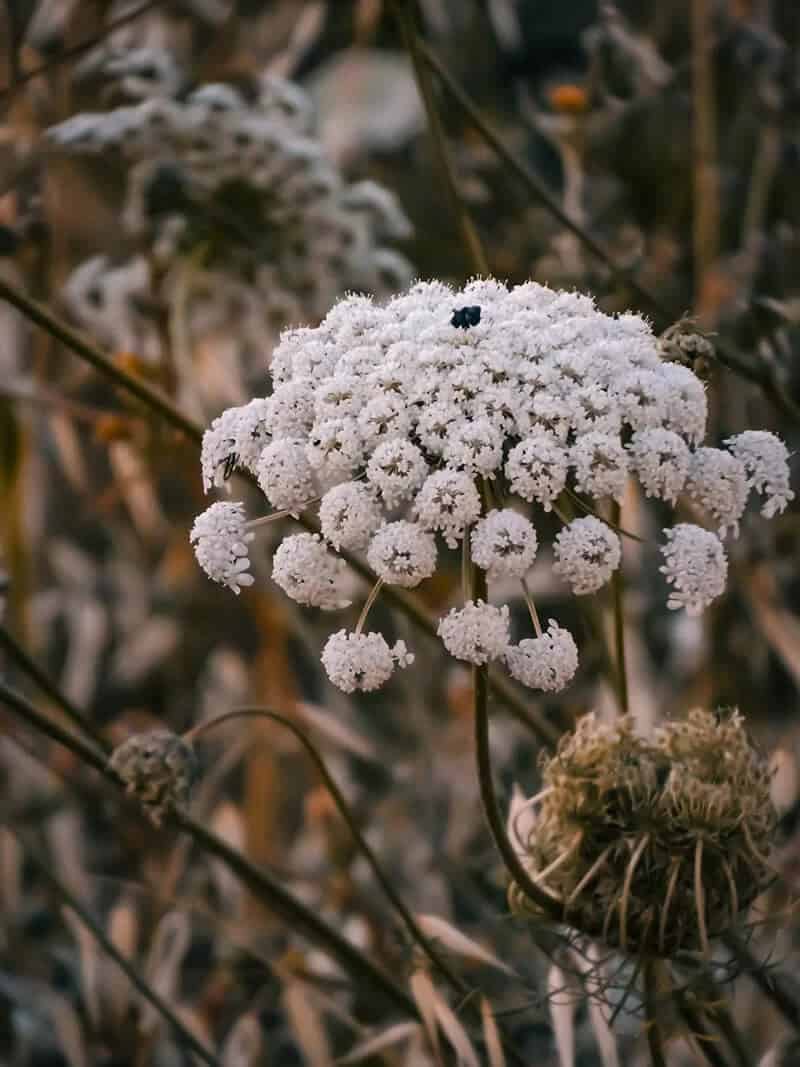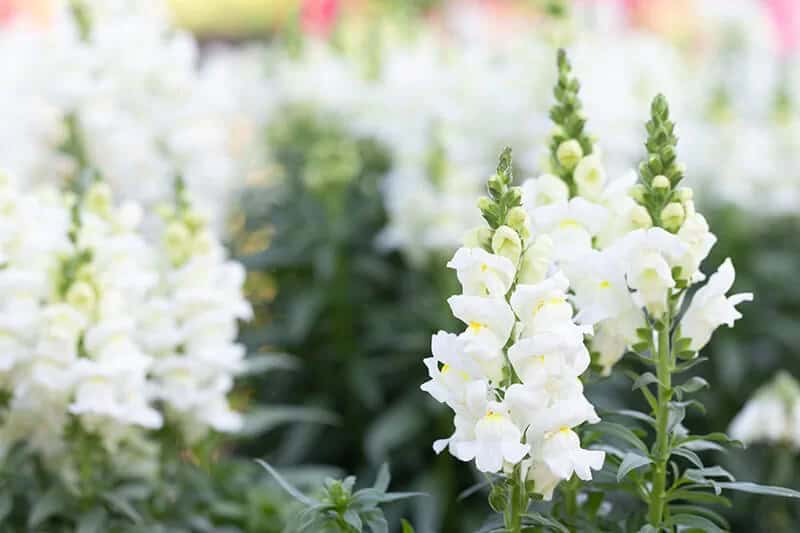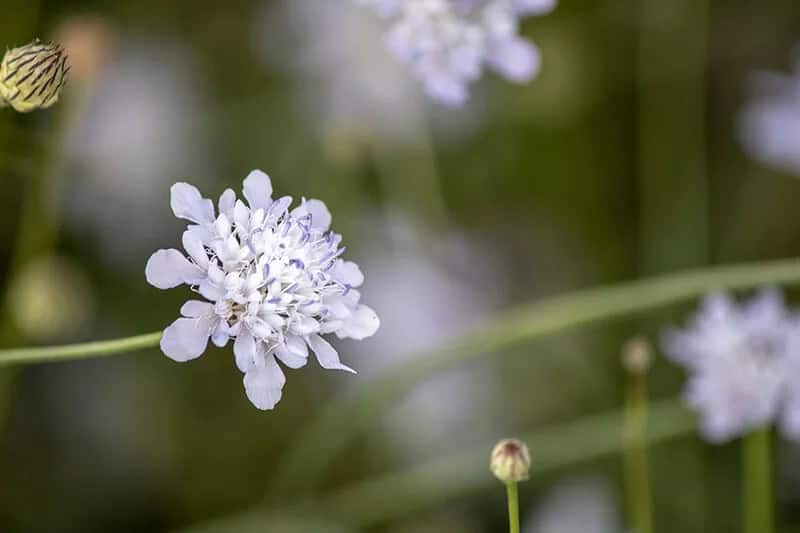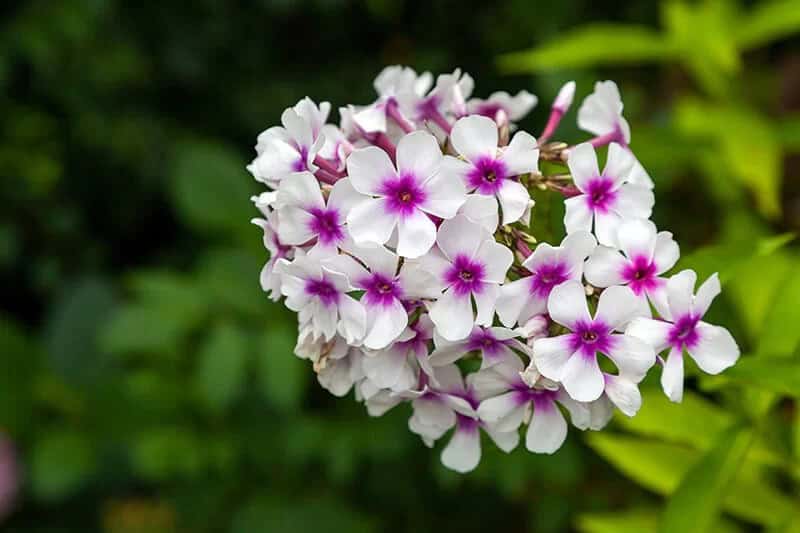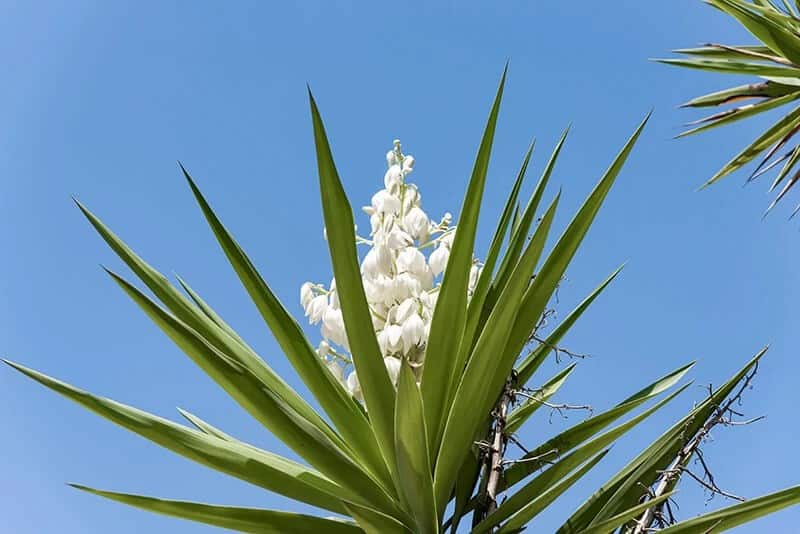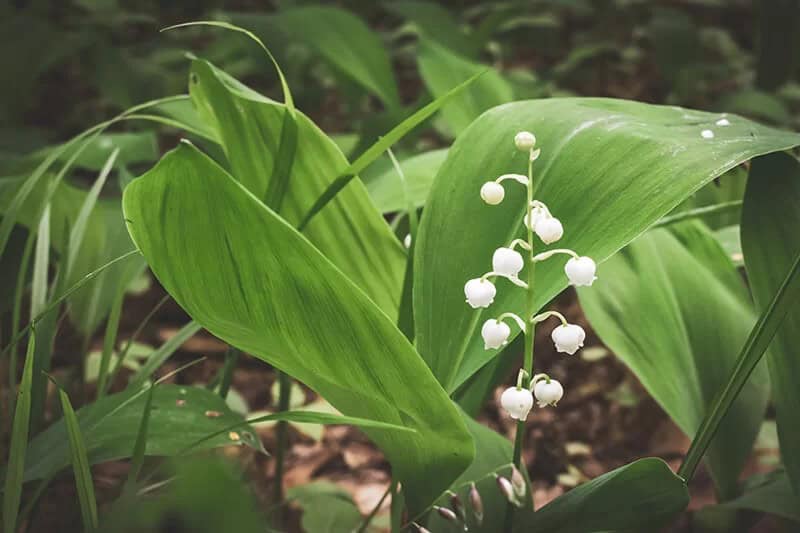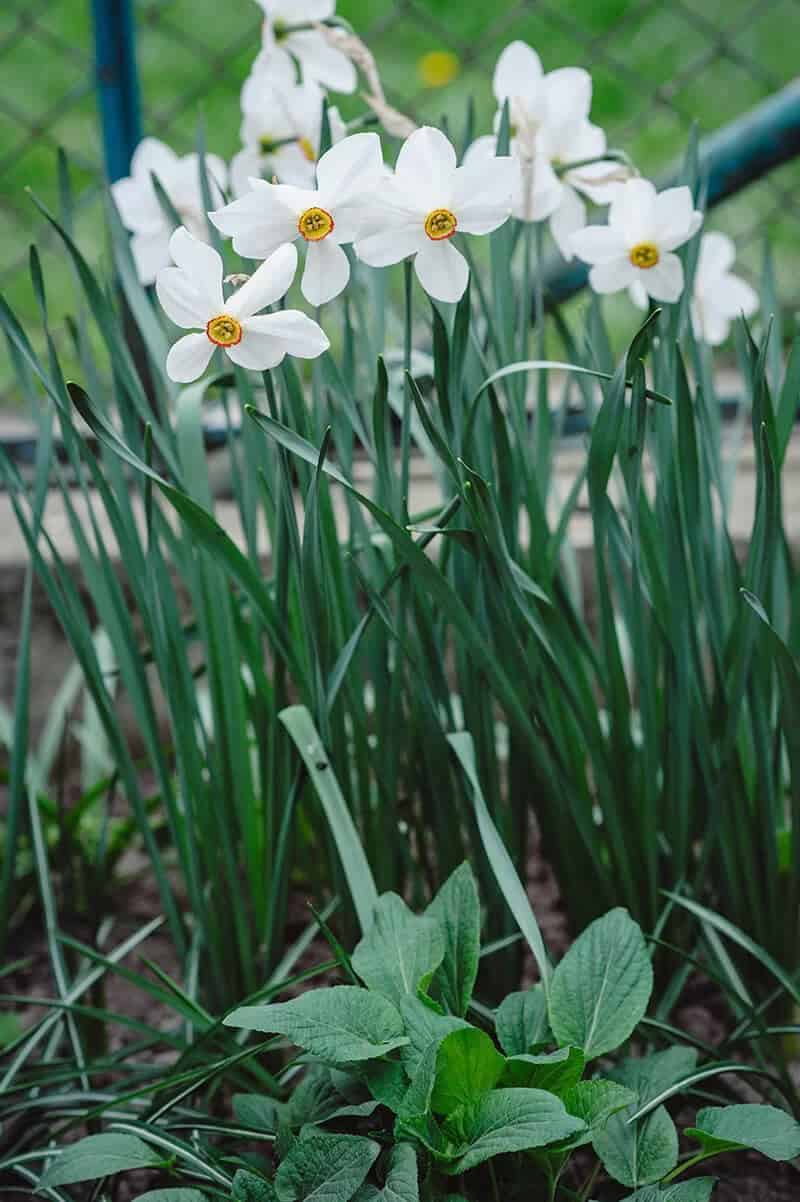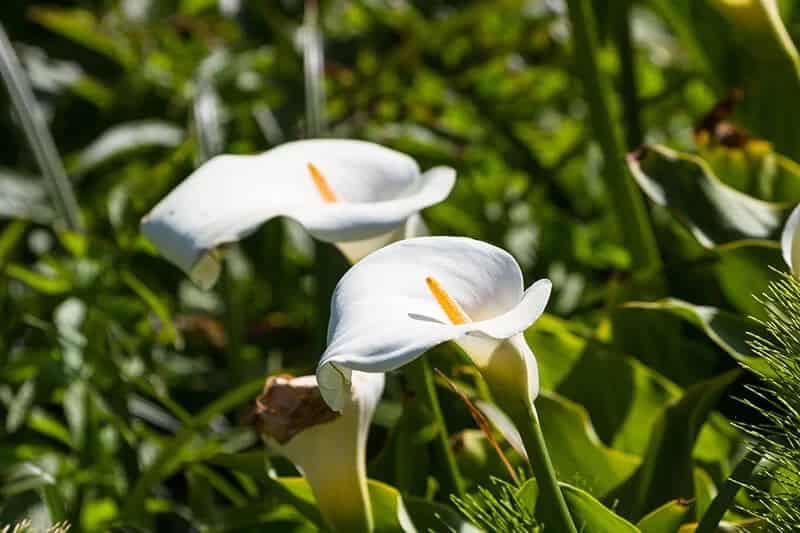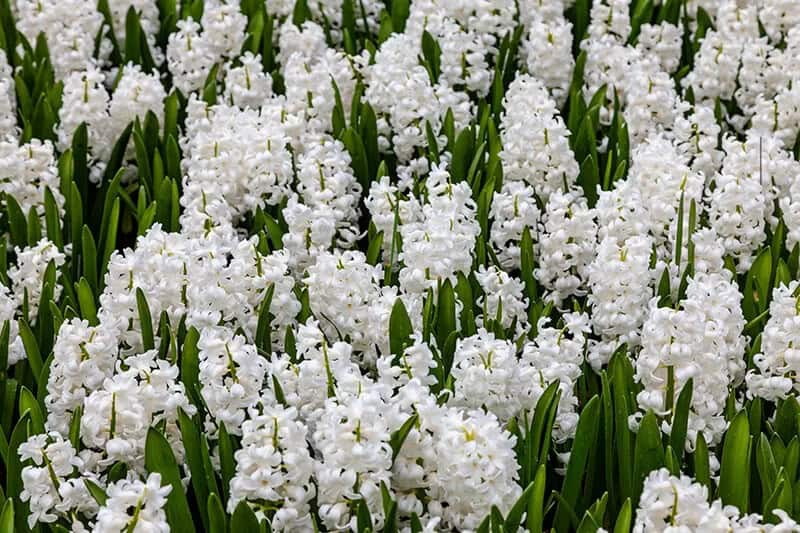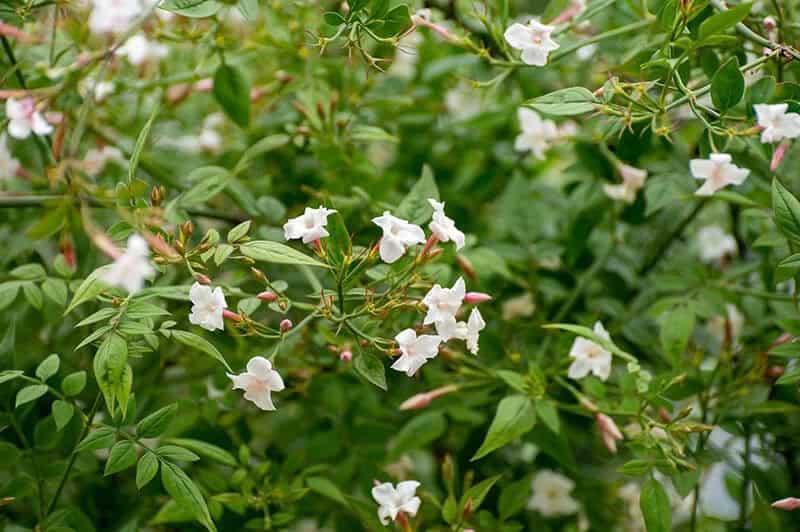When it comes to elevating the aesthetic of your outdoor space, selecting the right white flowers is an excellent starting point. Not only do they provide a sense of brilliance and radiance, but they also have the ability to pass on this visual appeal to surrounding floral colors. This unique quality makes them particularly well-suited for adding a touch of elegance to areas such as retainer walls, lawn borders, and flowerpots.
27 Unique White Flowers to Make Your Neighbors Do a Double Take
White flowers offer endless possibilities when it comes to creating visually appealing arrangements in your garden. You can opt for a single statement piece or go for a cluster of blooms, adding depth and visual interest. The beauty of choosing white flowers lies in the fact that you have a vast array of annuals and perennials to select from, allowing you to tailor your selection to suit your specific gardening needs.
Baby’s Breath (Gypsophila Paniculata)
The Baby’s Breath flower is a popular choice for wedding bouquets and other celebratory arrangements, thanks to its delicate white blooms and whimsical charm. This low-maintenance plant thrives in conditions of full sun and well-drained soil, making it an ideal addition to many gardens. With a growing zone range of 3-9, Baby’s Breath is suitable for most climates. Its unique features include symbolism tied to joy, purity, long-lasting love, and festive celebration.
In terms of care, the plant requires minimal watering – perfect for busy gardeners or those who tend to forget to water their plants from time to time! Blooming season typically occurs between June and September, making it a lovely addition to summer arrangements.
Mums (Chrysanthemum X Morifolium)
Mums, also known as button-nosed flowers, possess a rich symbolism tied to concepts such as hope, loyalty, honesty, and fidelity. This beautiful bloom thrives in environments with average and consistent water supply throughout the growing season, making it an ideal addition to any garden. Well-drained soil is also crucial for its growth, allowing the plant’s roots to breathe and absorb necessary nutrients. In terms of growing zones, mums are suitable for regions between 5 to 9.
They can tolerate a range of light conditions, from full sun to partial shade. The blooming season typically spans July to October, making them an attractive choice for late-summer to early-fall gardens. Interestingly, the original color of these flowers was gold, although they are now more commonly associated with a range of white hues. Some enthusiasts even refer to them as Spider Mums due to their unique, many-legged florets that resemble spider-like firework bursts.
With their captivating appearance and symbolic significance, mums are sure to bring joy and serenity to any outdoor space.
White Hydrangea (Hydrangea Macrophylla)
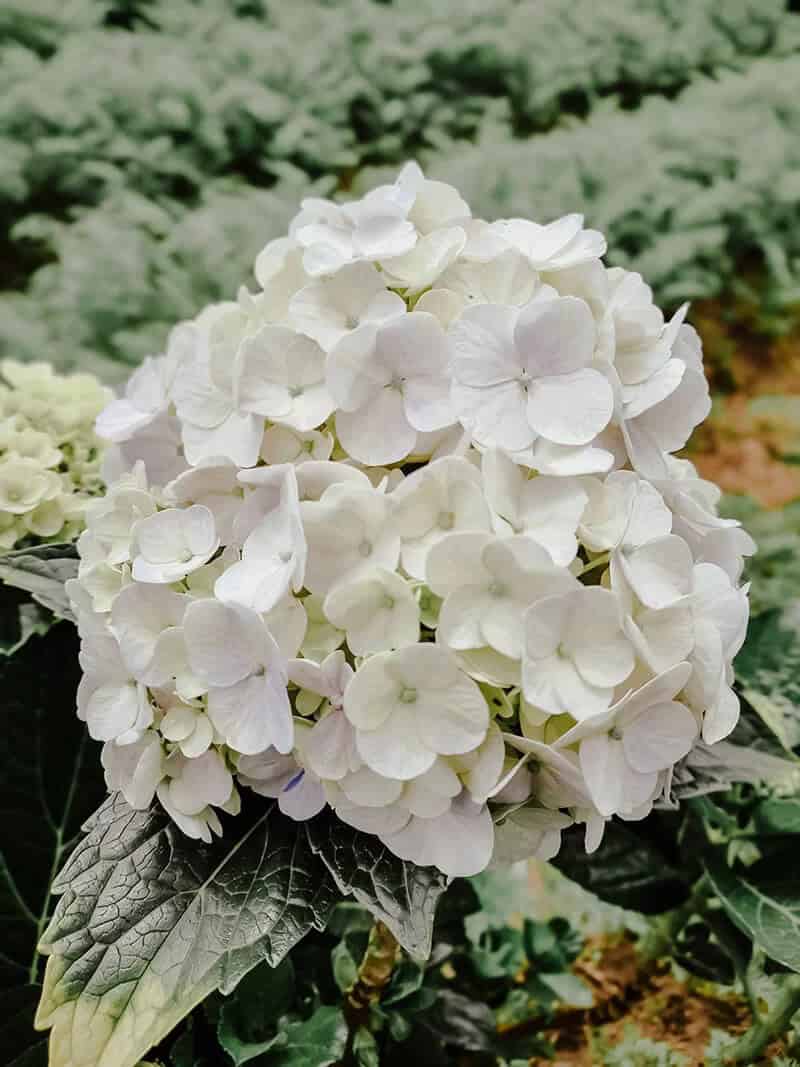
White Hydrangea flowers add a touch of elegance to any garden with their spherical blooms, making them a popular choice for creating visual interest. These versatile plants can thrive solo, clustered together or alongside other garden companions to create depth and dimension. With some varieties capable of growing up to 100 feet in the air, they offer a range of possibilities for creative expression.
Furthermore, these flowers are imbued with symbolism, representing wealth, vanity, purity, and grace, making them a meaningful addition to any outdoor space. To thrive, Hydrangeas require deep watering each week, especially in hot climates, as well as humus-rich soil that drains well and is suitable for containers. They can be grown in zones 3 to 7 and prefer full sun to partial sun conditions.
Blooming from May to July, they provide a delightful display of white flowers throughout the spring and early summer seasons.
Rhododendron (Rhododendron Cunningham’s White)
White Rhododendrons, with their striking funnel, tubular, and bell-shaped blooms, are a popular choice for gardens seeking elegance and seclusion. Their foliage is not only visually appealing but also long-lasting, making them an ideal addition to victory gardens and other settings where a touch of serenity is desired.
As they can thrive in a range of conditions, from 1-foot tall shrubs to towering specimens exceeding 20 feet, these versatile plants can be effortlessly integrated into any landscape design. When provided with the right environment – including well-drained soil with a mix of acidity and humus, consistent moisture, and filtered sunlight – White Rhododendrons will flourish, producing vibrant blooms from May to September.
Trumpet Flower (Brugmansia Suaveolens)
The white trumpet flower, often referred to as Brugmansia, boasts a unique and striking appearance, with its delicate petals resembling an angel’s horns. Despite its beauty, this plant is also notorious for being highly toxic if ingested. As a member of the Solanaceae family, which includes other poisonous plants like the devil’s trumpet, it’s essential to exercise caution when handling or consuming any parts of the white trumpet flower.
When it comes to growing conditions, this plant thrives in well-drained, acidic soil that is rich in moisture. It also requires consistent watering, particularly during its initial growth phase. Trumpet flowers can tolerate partial shade, but they do best in full sun. In terms of climate, they prefer zones 9 to 12 and bloom from June to August. When given the freedom to grow outdoors, trumpet flowers can reach heights of up to 30 feet.
They can also be successfully cultivated in containers, making them a versatile option for gardeners.
Snow Drop (Galanthus Nivalis)

Snowdrops (Galanthus nivalis) are delightful, low-maintenance bulbous plants that thrive after the last frost, symbolizing hope, tenacity, and rebirth. Their delicate, bell-shaped florets evoke a sense of flight, as if they’re about to take off. Despite being toxic to pets and humans, these charming flowers can be planted in clusters using gardening gloves, offering a fresh start for any garden.
In dryer climates, Snowdrops require consistent moisture, while their soil preferences range from sandy and well-drained to alkaline, acidic, or neutral. They flourish in zones 3 to 7, tolerating full-sun to partial shade. Blooming typically occurs from March to April, making them a lovely harbinger of spring.
Dendrobium Orchid (Dendrobium Cucumerinum)
Dendrobium Orchids are renowned for their stunning beauty, thoughtfulness, and refinement, often showcased in delicate containers that allow for tightly packed roots. This unique species thrives in a variety of settings, whether indoors or outdoors, and is known to bloom multiple times throughout the year. As they prefer partial sun and moist, well-drained soil, they can be grown in zones 9-12.
In fact, they require only occasional watering when slightly dried out, making them a low-maintenance yet elegant addition to any space.
Hibiscus (Abelmoschus Rosa-Sinensis)

Hibiscus, a vibrant white flower plant, is known for its showstopping blooms that can grow up to giant sizes. While each bloom only lasts around 2-3 days, the plant’s rapid production of new flowers means you won’t have long to wait until the next stunning display appears. Beyond its striking visual appeal, Hibiscus has also gained popularity for its potential health benefits, particularly in lowering blood pressure.
When it comes to growing conditions, this plant thrives in rich and organic soil, with an average water requirement that should be kept consistently moist. It’s well-suited for full sun exposure and can tolerate a wide range of temperatures, making it a great option for gardeners in USDA zones 5-9. Whether you’re looking to add some joy, hospitality, or simply a touch of love and beauty to your outdoor space, Hibiscus is definitely worth considering.
Peony (Paeonia Lactiflora Festiva Maxima)
The majestic Peony flower boasts a symbolic significance tied to shyness, honor, happy marriage, and compassion. Its beauty is undeniable, with head-heavy blooms that require some extra support from gardeners to prevent them from flopping due to their substantial size. As an added bonus, these flowers attract a variety of beneficial insects, including ants, who can’t get enough of their sweet nectar.
In terms of growing conditions, Peonies prefer evenly moist soil in the spring and fall, with neutral pH levels and full sun to partial shade. They thrive in USDA zones 3 to 8, making them a great addition to many gardens. The blooming season typically falls between April and June, during which time their stunning flowers put on a show.
Periwinkle (Catharanthus roseus, Vinca Minor)

White Periwinkle, a low-maintenance plant, is often found growing alongside trees due to its ability to thrive in partial shade and withstand drought conditions. Its symbolic significance includes achievement, everlasting love, and friendship, making it a popular choice for gardens. When it comes to its needs, Periwinkle requires low watering every other week, preferring sandy, loamy, or clay soils.
It’s suitable for growing zones 4 to 8 and can tolerate partial sun, full sun, or even full shade. The blooming season typically ranges from February to December. While they provide an abundance of ground cover, making them a popular border addition, it’s essential to note that Periwinkle can become invasive in certain areas.
Queen Anne’s Lace (Daucus Carota)
Queen Anne’s Lace, with its majestic frills perched atop slender stems, exudes a unique blend of delicacy and untamed beauty. This striking plant is deeply rooted in symbolism, representing safety, refuge, and strength. In terms of its environmental needs, Queen Anne’s Lace prefers dry soil and limited moisture, except during the early stages of seedling growth. A loamy, nutrient-rich substrate with a mix of clay or sand is ideal. Its hardiness allows it to thrive in USDA zones 3 through 9.
While full sun is preferred, partial shade can also support its growth. The plant’s blooming season typically occurs from June to August, during which time its large, showy frills are a treat to behold. Interestingly, Queen Anne’s Lace has historical significance, with some believing it was the signature look of Anne of Denmark, who wore a lace-like headdress adorned with similar frills.
Star of Bethlehem (Ornithogalum Umbellatum)
The Star of Bethlehem is a charming flower plant that originates from a bulb and is characterized by its star-shaped petals. Its leaves, resembling blades of grass, add to its natural beauty. This summer-blooming delight thrives in well-drained soil with a pH level ranging from acidic to alkaline. It requires average watering, keeping the soil consistently moist. The Star of Bethlehem enjoys full sun to partial shade and can be grown in USDA zones 4 to 9.
As it matures, this plant can act as a hedge and produce bulbils or baby bulbs that can be replanted elsewhere in your garden, creating a beautiful and lush display.
Snap Dragon (Antirrhinum Majus)
Snap Dragons are often associated with symbolism related to grace, mischievousness, and strength. These flowers thrive in environments that meet certain specific needs. They require average water intake, approximately 1 inch per week, and a moist, well-drained soil pH that is neutral to partially acidic. Snap Dragons can be grown in zones 7 to 11. They do best with partial shade or full sun exposure. As for blooming, these flowers typically flourish from May to August.
With proper care, they can even grow as borders on lawns or within containers, producing their characteristic snout-like petals that remain attractive well into the fall. Some varieties of Snap Dragons have been known to thrive in unexpected locations, such as between the cracks of walls, and new cultivars featuring white blooms have emerged for those who appreciate the creeping and climbing varieties.
Daisy (Leucanthemum x Superbum)
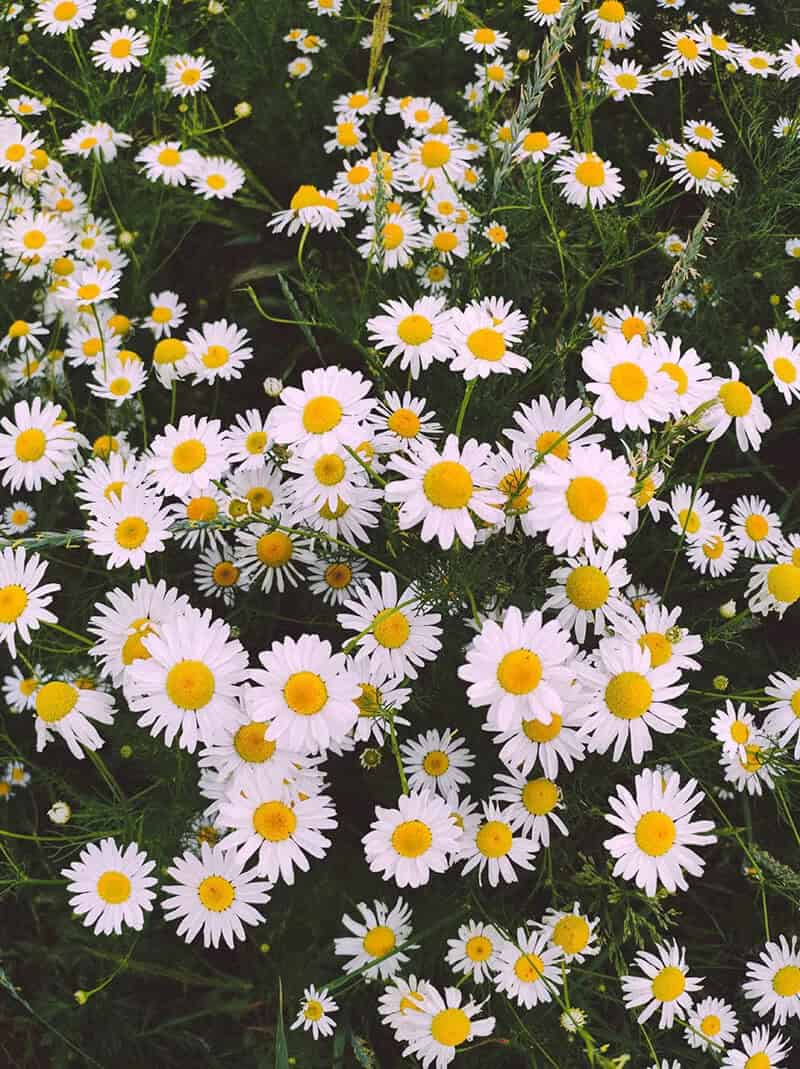
The Shasta White Daisy, a charming hybrid of bright yellow and white, has been delighting gardeners since its development in the 1800s. As a summer-loving plant, it boasts evergreen foliage that persists throughout the year, providing a lush backdrop for the arrival of bees and butterflies seeking nectar. With its long-lasting blooms and sunny disposition, it’s no wonder many enthusiasts adore cutting them to bring joy and cheer into their lives.
Scabiosa (Scabiosa Columbaria)
Scabiosa, a charming herbaceous perennial, brings warmth and peace to any garden setting with its delicate, fluttering blooms. These small flowers are not only visually appealing but also attract pollinators, making them a popular choice among cultivars. Dubbed ‘pincushion flowers’ due to their unique emergence, Scabiosa is a delight to behold during the spring and summer months.
Interestingly, the Latin name for this plant refers to its historical use in treating skin conditions such as scabies, highlighting its rich cultural heritage. With its modest size, low-maintenance requirements, and adaptability to various growing zones (3-7), Scabiosa is an excellent addition to any garden, requiring only 1 inch of water per week until maturity, with some drought tolerance, a moist and well-drained soil, full sun, and blooming season from May to July.
Phlox (Phlox Paniculata)
The phlox flower, a unique creeping herbaceous perennial, is characterized by its mesmerizing white petals. This variety thrives in woodland environments, where it can grow up to 2-4 feet tall. One of its most notable features is its sweet, floral scent that fills the air around the garden. Symbolically, phlox represents unity, great flame spirits, and sweet dreams. When it comes to growing conditions, phlox requires neutral soil with moderate moisture levels and good drainage.
Average watering is sufficient, but make sure to keep the foliage dry to prevent mildew issues from arising. In terms of light exposure, phlox prefers full sun or partial shade. Its blooming season typically occurs between June and July. With a growing zone range of 4-8, phlox can be cultivated in many parts of the world.
Yucca (Yucca Elephantipesis)
The yucca plant, a symbol of transformation, protection, mutuality, and purification, is a popular choice among gardeners and indoor houseplant enthusiasts. Its unique appearance, featuring thick stalks and sword-shaped leaves, makes it stand out from other plants. One of its most notable features is the bell-shaped flowers that bloom from June to August, adding a touch of elegance to any space.
But what’s even more impressive is its ability to purify indoor air, making it an excellent addition to any home. This adaptable plant thrives in low-water conditions and can tolerate a range of soil types, including sandy, perlite, and well-drained mixes. It’s also relatively easy to care for, as it prefers full sun and can grow well in zones 9-11.
Lily of the Valley (Convallaria Majalis)
Lily of the Valley, despite its name, actually belongs to the asparagus family rather than the lily family. However, this white flowered plant still boasts charming characteristics that make it a delightful addition to any garden. The sweet fragrance emitted by the small, bell-shaped petals is particularly endearing, and at maturity, the foliage of the plant gives rise to perfect little red berries. To thrive, Lily of the Valley requires well-drained soil with rich, neutral or acidic properties.
It also needs partial shade to full sun exposure and average water levels, just shy of drying out. The ideal growing zones for this plant range from 2 to 9, with a blooming season that typically spans April to August.
Ranunculus (Ranunculus Asiaticus)
Ranunculus, also known as the Persian Buttercup, boasts an astonishing 550 species of flowering plants that exude a romantic charm. The layered blooms often create a blushing bride bouquet, symbolizing the deep affection between couples. With its rich history, this plant is steeped in legend, with tales of kissing frogs, roaming wolves, and even Persian princes. As for its growing requirements, Ranunculus thrives in well-drained soil, preferring a sandy to loamy texture.
Average watering only when the soil turns dry is sufficient, while full sun provides the necessary light. This flowering beauty can be grown in zones 8-11, with peak blooming season occurring from March to May.
Daffodil (Narcissus Papyraceus)
Daffodils, with their vibrant white petals, are a symbol of new beginnings, high esteem, and chivalry. To keep them thriving, it’s essential to provide consistent moisture through regular watering. The soil should be kept moist, rich, and well-drained, with a neutral or slightly acidic pH. Daffodils are hardy plants that can grow in zones 4 to 8, but they do require full sun to partial shade to reach their full potential.
In terms of blooming season, daffodils typically start to bloom in February and March. As the flowers fade and go dormant, it’s crucial to cultivate the bulbs to ensure healthy growth for future seasons. When grown in deep pots, daffodils can spread out their roots, making them a delightful addition to any garden.
Amaryllis (Amaryllidaceae Hippeastrum)
The Matterhorn Amaryllis is an excellent choice for starting a garden, symbolizing self-determination, fortitude, and pride. This variety of white flowers thrives in average water conditions, requiring 2 inches of watering each week during its growth period, followed by a dry rest phase once mature. Well-drained soil is also essential for optimal growth. The Matterhorn Amaryllis is hardy in growing zones 8 to 10 and can tolerate full sun or partial shade.
As an added bonus, it blooms from March to May, making it perfect for indoor or outdoor arrangements during the holiday season. When paired with its red counterpart, the two varieties create a stunning festive design. The name ‘Matterhorn’ is fitting, as this Amaryllis truly shines.
Calla Lilly (Zantedeschia Aethiopica)
The majestic White Calla Lily, with its striking single bloom, struts down the botanical runway like a supermodel. Its name is deeply rooted in Greek mythology, linked to the powerful Goddess Hera. This elegant flower exudes sensuality and curves, making it an ideal gift for someone special. Despite its toxic parts being highly poisonous to humans, the White Calla Lily has become a timeless wedding favorite, often featured in bouquets and arrangements.
As we delve into this captivating plant’s world, let’s explore its symbolism, growing conditions, and stunning appearance.
Symbolism: The White Calla Lily embodies beauty, faith, and holiness, making it an apt choice for weddings and special occasions. Its unique shape and delicate petals evoke a sense of purity and innocence.
Water Needs: While the White Calla Lily doesn’t require excessive watering, it does need consistent moisture, especially in drier climates.
Aim to provide it with water once a week, adjusting according to your local climate.
Soil Needs: This plant thrives in well-drained, acidic soil that’s kept consistently moist. Avoid overwatering, as this can lead to root rot.
Growing Zones: The White Calla Lily is hardy and adaptable, growing best in zones 8 to 10. With proper care, it will reward you with stunning blooms.
Light Needs: This plant enjoys partial shade to full sun, making it suitable for a variety of indoor and outdoor settings.
Gardenia (Gardenia Jasminoides)
The Gardenia’s unique charm lies not only in its exquisite white blooms but also in its symbolic significance, representing expansiveness, clarity, and carefree joy. To cultivate this finicky yet rewarding partner, one must provide the right conditions. Consistent moisture is essential, with drip irrigation being an ideal solution to meet its water needs. Well-drained soil that’s kept moist, preferably using a peat-based potting mix in containers, will also ensure the plant thrives.
Gardenias are typically found in USDA hardiness zones 8 to 11 and require partial shade to prevent scorching. Blooming seasonally from May to September, these white flowers often take a few years to reach their full potential. Notably, their petals resemble those of rose plants, making them a great choice for indoor arrangements.
Tuberose (Polianthes Tuberosa)
Tuberose, a fragrant and elegant plant, is synonymous with passion, erotic love, and peace. Its unique characteristics make it a sought-after ingredient for essential oil production, with some willing to pay a premium for its distinctive scent. The foliage of tuberose resembles grass, typically reaching lengths of 2-3 feet. A notable feature of this asparagus-related plant is the waxy overlay that protects it from scorching heat.
However, it has one condition: it will not bloom if the weather is too hot. On the other hand, it thrives in cool climates, making it an ideal choice for gardeners seeking to cultivate a low-maintenance yet fragrant addition to their outdoor spaces.
Hyacinth (Hyacinthus Orientalis)
Hyacinth, with its striking white blooms resembling miniature starfish, is an iconic flower plant steeped in symbolism. The petals symbolize love, commitment, pride, and power. To thrive, these plants require consistent watering and a specific set of environmental conditions. Specifically, they need moist, well-drained soil that’s either neutral or slightly acidic, and are most comfortable growing in zones 4 to 8. In terms of light, Hyacinths prefer full sun to partial shade.
As for blooming season, expect these flowers to burst forth in March and April. Interestingly, there are over 50 varieties of Hyacinth, offering a range of scents that can be experienced indoors using bulb forcing jars.
Jasmine (Jasminum Polyanthum)
Jasmine flowers are a popular choice among gardening enthusiasts due to their captivating scent and visually appealing appearance. This type of flower is deeply rooted in symbolism, representing spiritual awakening, feminine power, community, and love. Whether you’re looking for a statement piece for your outdoor trellis or an elegant addition to your indoor space, Jasmine’s vining habit makes it an ideal choice.
To thrive, Jasmine requires well-drained alkaline, neutral, or acidic soil, moderate watering with good drainage, and can tolerate partial sun to full sun conditions. With a growing zone range of 8-12, this flower blooms from March to September, making it a perfect addition to any garden throughout the spring and summer seasons.
Zinnia (Zinnia Elegans)

The large white Zinnias are a standout choice for gardeners of all levels, boasting a trifecta of desirable traits: ease of care, pest resistance, and stunning blooms. These award-winning flowers thrive in well-drained soil with a pH range that’s surprisingly accommodating – from alkaline to acidic. They’re also drought-tolerant, making them an excellent option for busy gardeners or those who tend to forget to water their plants (just ask the absent friends symbolized by these blooms).
With a growth zone spanning 2 to 11, and full sun to brighten up any spot, it’s no wonder Zinnias are a popular choice. Add to that a blooming season that runs from April to September, and you’ve got a flower that will keep on giving all summer long. Whether they’re container-bound or adding pops of white to your garden beds, the flat-faced blooms of Zinnia varieties like Zahara White, Starlight Rose, Crystal White, and Peter Pan Cream are sure to bring joy.
27 Perfect White Flowers to Make Your Garden Brilliantly Sparkle
Planting white flowers in your garden can be a great way to add visual interest and symbolism to your outdoor space. With a wide range of shapes, sizes, and varieties to choose from, you’re sure to find the perfect white blooms to suit your style and preferences. Whether you prefer pure white flowers or those with a touch of cream or yellow, there’s something for everyone.
From easy-to-grow varieties that require minimal maintenance to more challenging options that will test your gardening skills, there’s a white flower out there waiting to be discovered. And the best part? You’ll get to enjoy the fruits of your labor and take pride in your beautiful garden, whether it’s indoors or outdoors.
